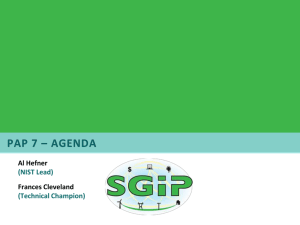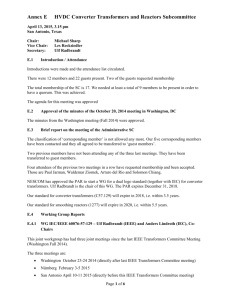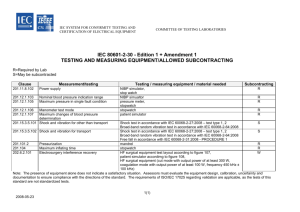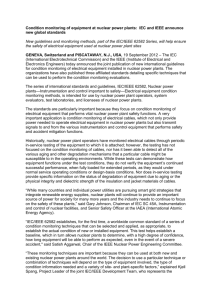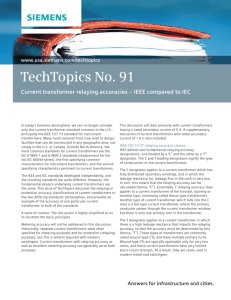F14-AnnexE-HVDC - IEEE-SA
advertisement
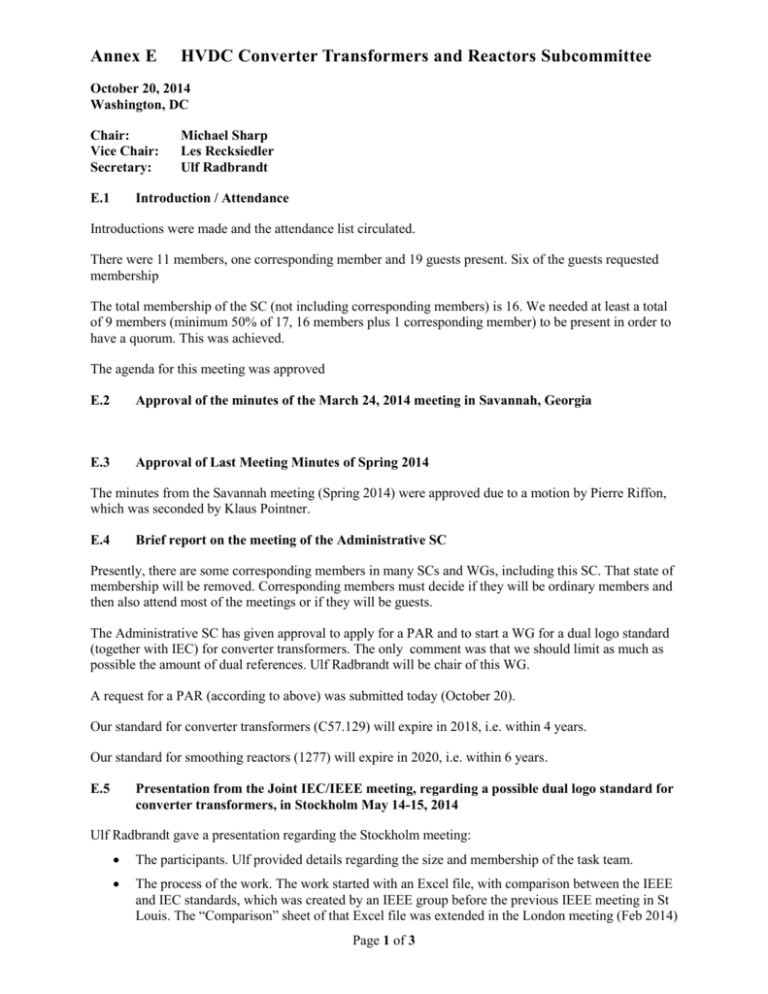
Annex E HVDC Converter Transformers and Reactors Subcommittee October 20, 2014 Washington, DC Chair: Vice Chair: Secretary: E.1 Michael Sharp Les Recksiedler Ulf Radbrandt Introduction / Attendance Introductions were made and the attendance list circulated. There were 11 members, one corresponding member and 19 guests present. Six of the guests requested membership The total membership of the SC (not including corresponding members) is 16. We needed at least a total of 9 members (minimum 50% of 17, 16 members plus 1 corresponding member) to be present in order to have a quorum. This was achieved. The agenda for this meeting was approved E.2 Approval of the minutes of the March 24, 2014 meeting in Savannah, Georgia E.3 Approval of Last Meeting Minutes of Spring 2014 The minutes from the Savannah meeting (Spring 2014) were approved due to a motion by Pierre Riffon, which was seconded by Klaus Pointner. E.4 Brief report on the meeting of the Administrative SC Presently, there are some corresponding members in many SCs and WGs, including this SC. That state of membership will be removed. Corresponding members must decide if they will be ordinary members and then also attend most of the meetings or if they will be guests. The Administrative SC has given approval to apply for a PAR and to start a WG for a dual logo standard (together with IEC) for converter transformers. The only comment was that we should limit as much as possible the amount of dual references. Ulf Radbrandt will be chair of this WG. A request for a PAR (according to above) was submitted today (October 20). Our standard for converter transformers (C57.129) will expire in 2018, i.e. within 4 years. Our standard for smoothing reactors (1277) will expire in 2020, i.e. within 6 years. E.5 Presentation from the Joint IEC/IEEE meeting, regarding a possible dual logo standard for converter transformers, in Stockholm May 14-15, 2014 Ulf Radbrandt gave a presentation regarding the Stockholm meeting: The participants. Ulf provided details regarding the size and membership of the task team. The process of the work. The work started with an Excel file, with comparison between the IEEE and IEC standards, which was created by an IEEE group before the previous IEEE meeting in St Louis. The “Comparison” sheet of that Excel file was extended in the London meeting (Feb 2014) Page 1 of 3 Annex E with two new columns, one for comments and one for a complexity level for each clause of the standards. The complexity levels were 1 to 5 where 1 is “Easy” and 5 is “Very hard”. Prior to the Stockholm meeting, Anders Lindroth (convener of IEC MT 61378-2) had created a draft merged document, which contained all IEC text in black together with the corresponding IEEE text (clause by clause) in blue. During the Stockholm meeting, the participants worked through the merged draft document (clause by clause) and decided what information should be selected for each clause and updated the draft accordingly. About 26 of 72 pages were completed. The Agreements and actions from the Stockholm meeting were the following: We discussed a proposal from Ugo Piovan, to set a voltage limit in the scope, but decided not to do this as it might exclude some low voltage back-to-back transformers. The exclusions of converter transformers for industrial and traction applications was regarded as sufficient. We did not discuss the list of letter symbols, but transferred them to an Excel-file and Ulf Radbrandt undertook to make a proposal for a common list of symbols. Our goal is to agree on one method to measure the load losses including the harmonics. To be able to make a comparison of the two present methods, Mats Berglund, Frank Trautmann and Sheila Batey will collect data on comparison measurements made with both methods, if any available, and make comparison measurements on converter transformers to be tested before the next meeting. As a backup solution (if we fail to agree on one method), we can have one IEEE method and one IEC method We did not reach a final agreement on the definition of rated current. Should it include harmonics per IEEE or be without harmonics per IEC? All members agreed to prepare for a discussion and agreement at the Washington joint meeting. The reference to different standards. The IEEE standard refers to many other IEEE standards and the IEC standard refers to many IEC standards. This is proposed to be handled with the following text (from the draft): Use of normative references. This standard can be used with either the IEC or IEEE normative references but, other than for IEC/IEEE dual-logo document references, the references shall not be mixed. The purchaser shall include in the enquiry and order which normative references are to be used. If the choice of normative references is not specified, then IEC standards shall be used except for HVDC converter transformers intended for installation in North America where IEEE standards shall be used E.6 Open discussion regarding the work for a dual logo standard for converter transform Thursday and Friday this week (October 23-24), there will be a joint IEC/IEEE meeting, which will continue the work from the Stockholm meeting. Discussions here will be input to the joint meeting. 1) The different methods for IEC and IEEE for measurement of losses Pierre Riffon has sent (29 March 2014) reference to loss measurements with both (IEC and IEEE) methods of loss measurement. Normally IEEE measurements gives slightly lower losses according to those measurements. That will be considered during the joint meeting. During the work for a dual logo standard for transformers for wind turbine applications, there were a lot of discussions regarding dual references. We should try to agree upon one method for loss calculation. Page 2 of 3 Annex E Peter Heinzig made a presentation regarding the loss measurement comparison several years ago, but at present he doesn’t have access to that presentation. A further search will be conducted to try to find this information. 2) Definition of rated current Rated current includes harmonics in the IEEE standard but does not in the IEC standard. We must agree upon one definition. Rated current and rated power (which follows rated current) are essentially only values that are provided on drawings and on the nameplate for reference. These values do not affect the design. The thermal design and the temperature rise test does anyway take the whole current spectra into account. It is important though to clearly define the impedance in percent. Independent on definition of rated current, the short circuit impedance in percent must be defined correctly in order to give the correct impedance in ohm. The standard should clearly define rated current, voltage, power and impedance. A motion was put forward by Les Recksiedler and seconded by Pierre Riffon to vote for the preferred definition of rated current. The vote result was that 1 person preferred that rated current should only be based on fundamental frequency current and 8 persons preferred that rated current also includes harmonics. 3) Coming joint work meetings No further joint meetings (after the Thursday and Friday meetings) are planned now but they will be needed in order to produce a draft that can be distributed for comments. Minutes from joint working group meetings will be distributed within the SC. E.7 Old Business None. E.8 New Business None. The meeting was adjourned at 4.09 pm. Page 3 of 3



